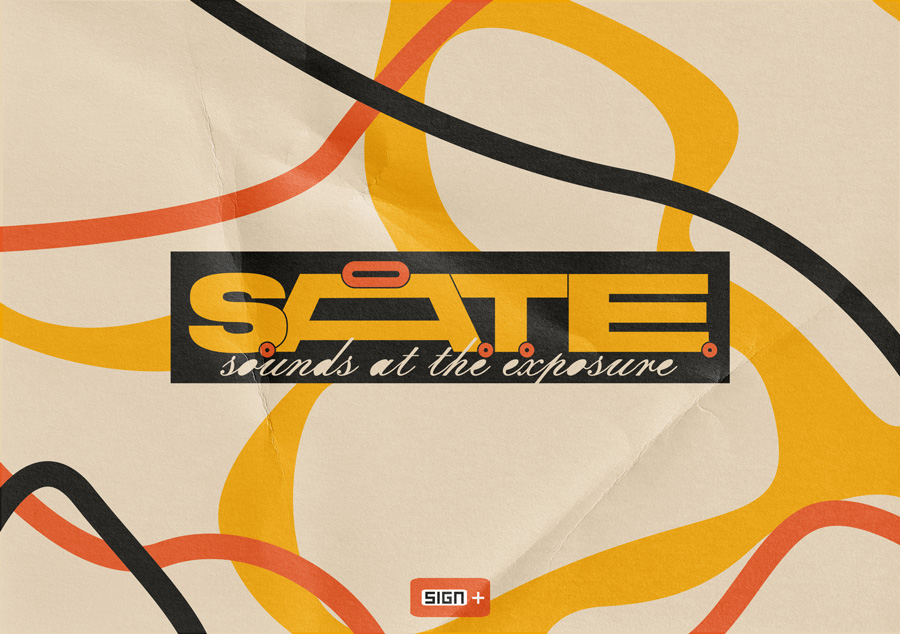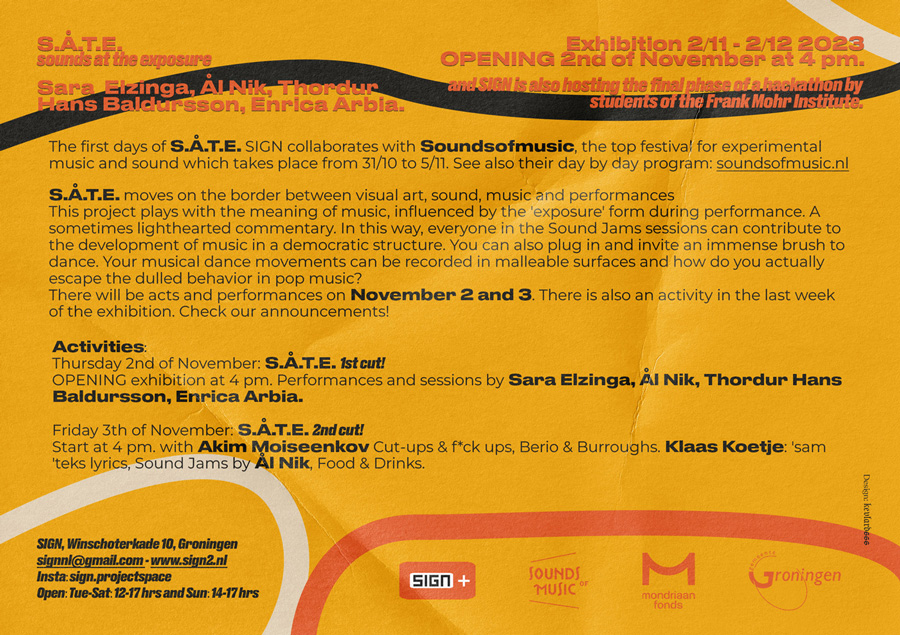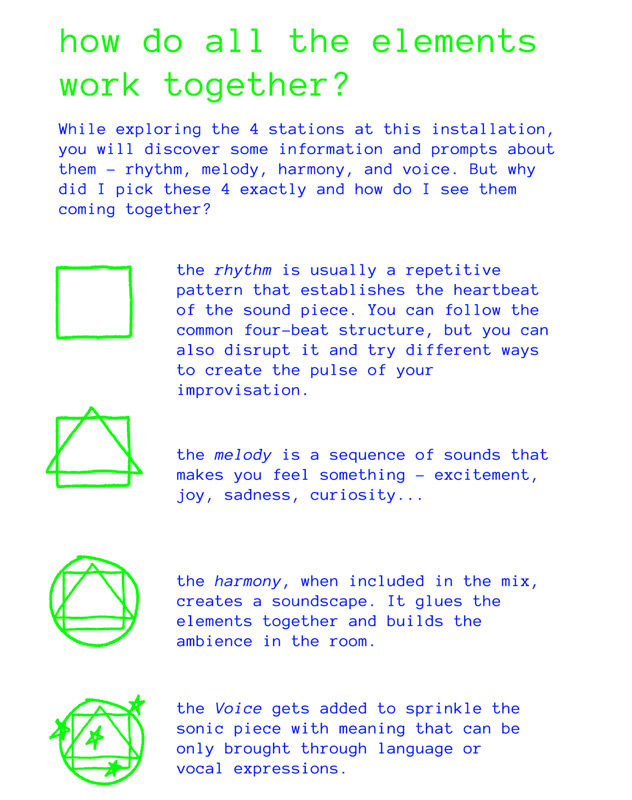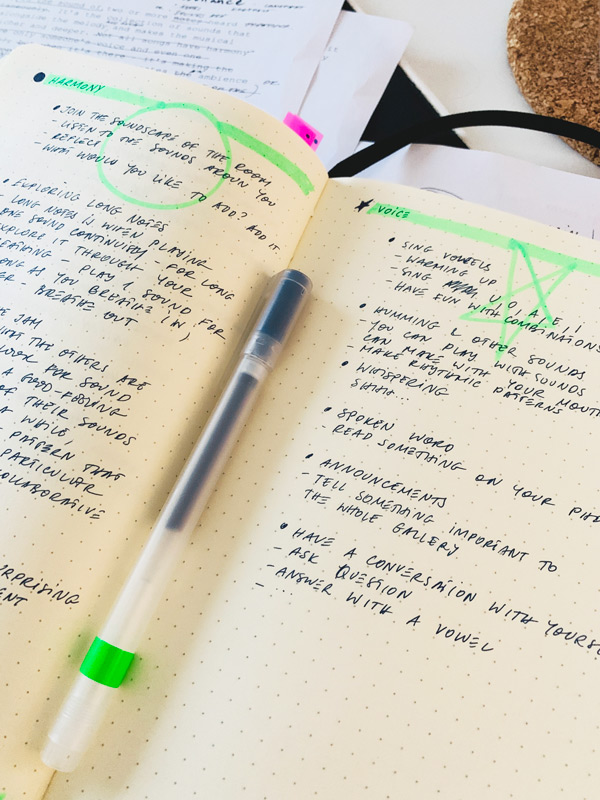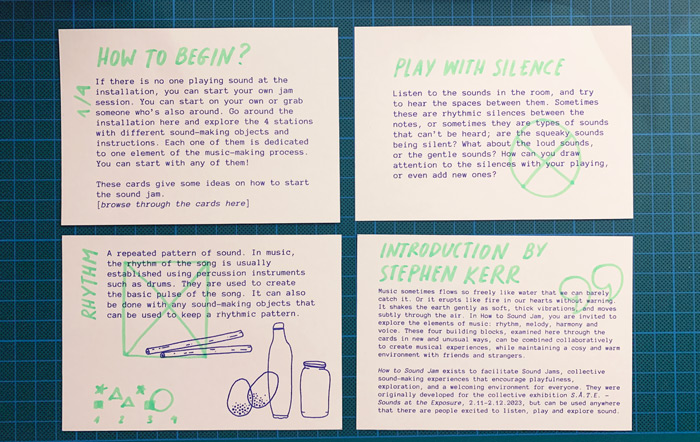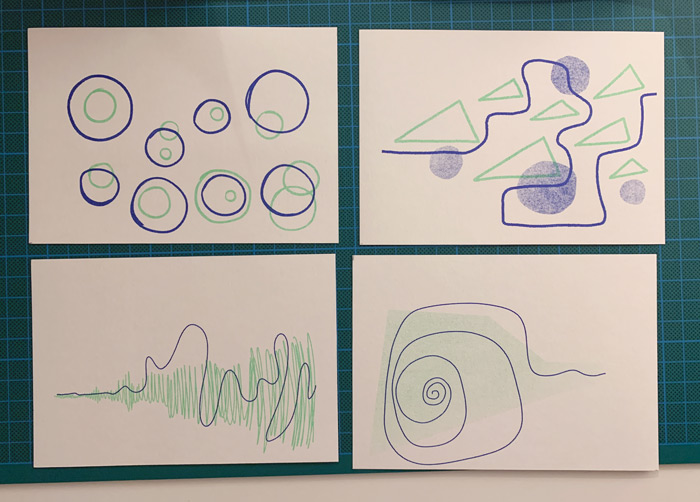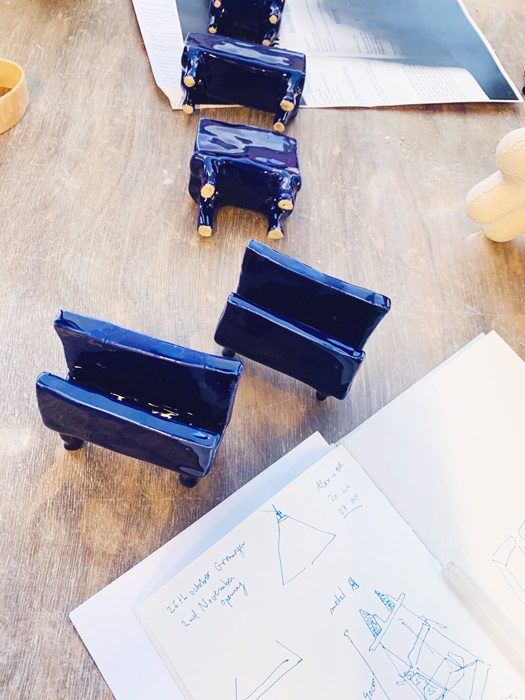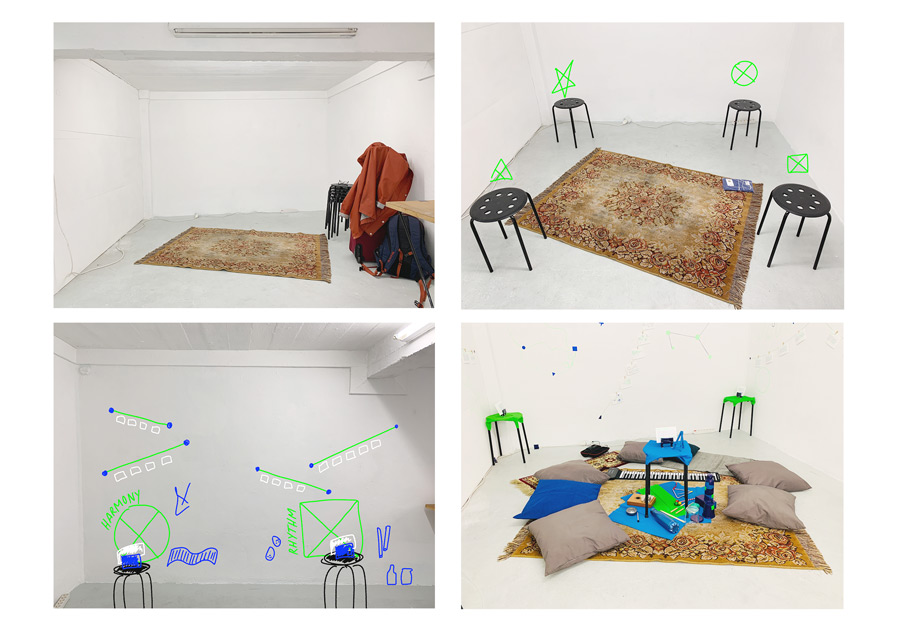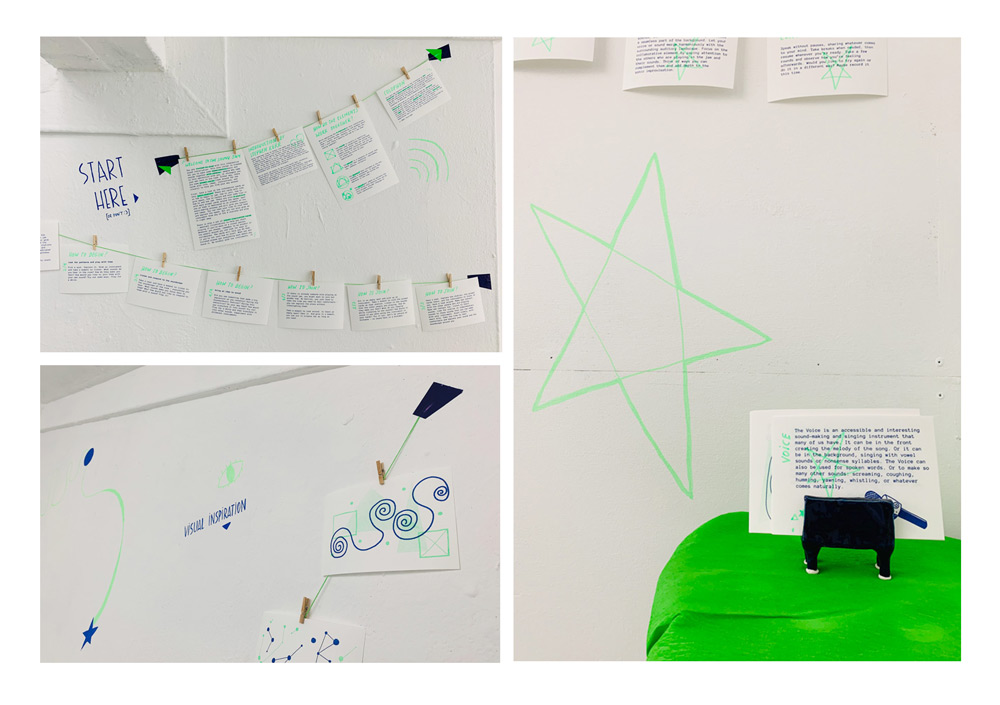Sound jams: sounds at the exposure
// documentation page of my work for the exhibition //
_invitation
s.å.t.e. - sounds at the exposure
The show moves on the border between visual art, sound, music and performances. This project plays with the meaning of music, influenced by the ‘exposure’ form during performance. A sometimes lighthearted commentary. In this way, everyone in the Sound Jam sessions can contribute to the development of music in a democratic structure. You can also plug in and invite an immense brush to dance. Your musical dance movements can be recorded in malleable surfaces and how do you actually escape the dulled behaviour in pop music? There will be acts and performances on November 2 and 3. There is also an activity in the last week of the exhibition. With this project, SIGN also participates in the Soundsofmusic festival, the top festival for experimental music and sound.
Artists: Sara Elzinga, Ål Nik, Thordur Hans Baldursson, and Enrica Arbia.
_Sound Jam at the Exposure
My new Sound Jam is a playful place that invites you to leave your [musical] experience behind and let yourself try out things you didn't have the chance to do before. With the help of some visual invitations [text prompts & visual inspirations], I propose the visitors to explore ways to make experimental music, noise and sounds and to disrupt the traditional playing in a band. The stage is as cosy as a living room and the sound-making instruments and objects are accessible and fun. This interactive installation suggests the guests explore some traditional music-making elements and disrupt them. To have conversations about how to approach the collective sound-making.
opening: 2-11-2023, 4pm CET exhibition runs: from 2-11 until 2-12-2023 SIGN project space Winschoterkade 10 9711 EA Groningen
_context
During the first days of our exhibition, SIGN collaborates with Soundsofmusic, a festival for experimental music and sound. The context of my work for this show comes from the invitation to become part of an experimental music-making process and I wanted to create a space where the visitors of the festival, and the exhibition, can become makers, too.
Since my previous Sound Jams focused on the process of creating a safe space and making it accessible for people from different backgrounds, I wanted to continue that fundamental line of work in this one as well. I asked myself questions like "how can a person without musical training approach experimental music-making?" or "how can I invite a person with technical experience to let go of it and simply play at my installation?". The interactive space I am building had to be able to accommodate some information and prompts to support the visitor in the process of exploring how to make it happen - how to sound jam. It also had to give appropriate and accessible sound-making objects, many of which should be easy-to-use musical instruments. In order to make it less scary, it should be acoustic - I should limit the possibility of microphonics, or other scary and disturbing situations within the technical setup. I wanted the space to be welcoming, cosy, warm, and chill. It should make you feel comfortable enough to stay there, read, explore, try out things, experiment, and connect with others. How to create opportunities for the visitors to experience things but not limit them too much with strict instructions?
_build-up
_prompt cards // As a major part of this work, the prompts were created carefully, after many iterations. I got massive help from Stephen Kerr who helped me with discussions about the instruments and the instructions, editing the cards' texts, and writing an introduction to the card deck How to Sound Jam.
The prompts are divided into two big groups: there are the introductory general ones that are placed at the entrance of the installation; and also specific ones on each of the four stations with sound-making objects: cards about rhythm, melody, harmony, and Voice. The general prompts give info about the whole setup and how to navigate in it. They also help the visitor with some ideas on how to start jamming, how to join if there are people playing already, how to give space to others, and more. Here I also explain why I created four stations at the installation.
There are also 4 groups of prompt cards placed on each station: rhythm, melody, harmony, and voice. There is a short intro giving a brief explanation of what these 4 elements mean [to me]. There are also cards with ideas on how to play with particular instruments and ideas on how to disrupt them.
The process of creating the cards started with exploring ways to conceptualise the four main stations and focus on the most important and simple explanation of the four elements. Then, I wrote the prompts that were supposed to invite the maker to experiment at each of the four stations in different ways. After the help of an editor - Stephen Kerr - the cards were illustrated and printed with a risograph. In addition, the cards deck will become a publication that I will publish and distribute after the exhibition - with the intention to share these new ideas of how to Sound Jams on your own.
// cards were printed with riso + hand-drawn, 120 gr paper
_card holders // In order to have a custom and unique display of the prompt cards, I contacted my friend, artist Gersande Schellinx. She designed them with the intention of playing with ceramics and using that material to create something with a character that would fit the overall mood of the installation.
_sound-making objects & instruments // The final list of sound-making objects and instruments at the installation:
_station rhythm // egg shaker x2, bamboo sticks x2, glass jar, metal bottle, plastic bottle _station melody // tongue drum, kalimba _station harmony // rubber rolling piano, triangle, pen bell _station Voice // karaoke microphone
_installation setup
The Sound Jam installation takes place in the basement area at SIGN gallery. In a cosy corner, surrounded by three walls. When actually seeing the space, I changed my initial plans and decided to use the walls to display all the prompt cards there using strings; and to illustrate some parts of the wall. The space was fitting perfectly for the installation idea - to create a dedicated space for jamming - a bit away from other works and with good acoustics.
_jamming area // the middle of the installation is a cosy space for people to sit down and jam. There are three carpets and seven cushions. The instruments and sound-making objects are placed in the middle. Also, in centre of the space there is the recording station - a prompt card with info on how to record; and a tiny easel for people to place their phone when recording.
_prompt cards // the three walls are covered with the prompt cards on display. The visitors can walk around and read all of them - all the cards are exhibited on the walls. There are also five stations with custom-made ceramic hard holders. Those cards are there for the visitors to take and look at while sitting and jamming.
_easter egg // the lights are dimmed with used papers - those sheets actually contain my notes during the editing session with Stephen Kerr. I reused the same papers here while drawing the wall - for support while using the markers. Their third life's purpose is now making the light less aggressive for the Sound Jam. :-)
_publications
_coming soon <How to Sound Jam Card Deck> // contact me if you're interested in getting the deck of prompt cards
_introduction by Stephen Kerr
Music sometimes flows so freely like water that we can barely catch it. Or it erupts like fire in our hearts without warning. It shakes the earth gently as soft, thick vibrations, and moves subtly through the air. In How to Sound Jam, you are invited to explore the elements of music: rhythm, melody, harmony and voice. These four building blocks, examined here through the cards in new and unusual ways, can be combined collaboratively to create musical experiences, while maintaining a cosy and warm environment with friends and strangers.
How to Sound Jam exists to facilitate Sound Jams, collective sound-making experiences that encourage playfulness, exploration, and a welcoming environment for everyone. They were originally developed for the collective exhibition S.Å.T.E. - Sounds at the Exposure, 2.11-2.12.2023, but can be used anywhere that there are people excited to listen, play and explore sound.
_colophon
This work was possible thanks to the invitation by Ron Ritzerfeld and Marie-Jeanne Ameln who run SIGN project space in Groningen and working with whom was such a pleasure! The Sound Jam was commissioned to be part of the collective exhibition S.Å.T.E. - Sounds at the Exposure, 2.11-2.12.2023. Financially supported by Mondriaan Fonds & Gemeente Groningen.
Eternal gratitude to the people who helped me:
Gersande Schellinx, for creating custom ceramic card holders for the prompts at the installation.
Stephen Kerr, for supporting me with some musical theory knowledge and editing.
mistitron and Kamo for trying out the instruments.
All the visitors who dared to play and experiment at my sound installation.
Sound Jams is a series of collective sound-making experiences facilitated by Ål Nik [Alexandra Nikolova].
_references & inspirations
★ Cardew C. (ed.), (1969). Nature Study Notes. Scratch Orchestra, Experimental Music Catalogue.
★ Cardew C. (1971). Towards an Ethic of Improvisation. Treatise Handbook Edition Peters
★ Mathieu, W.A. (1991). The listening book : discovering your own music. Boston: Shambhala. // ▶▶Audio version
★ Toop, D. (2016). Into The Maelstrom: Music, Improvisation and the Dream of Freedom. Before 1970. New York: Bloomsbury Academic.
★ Yōko Ono (1971). Grapefruit. New York: Simon And Schuster.
